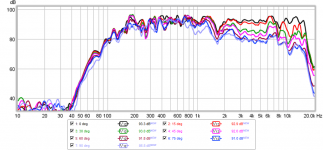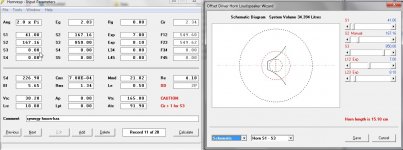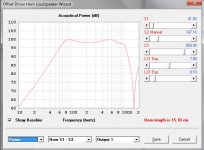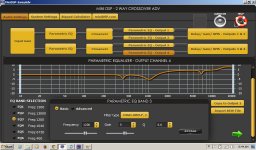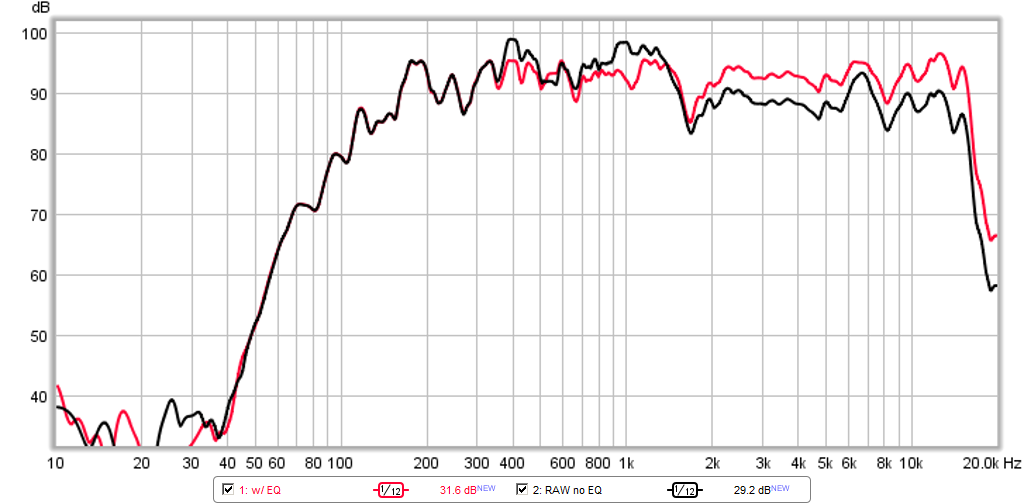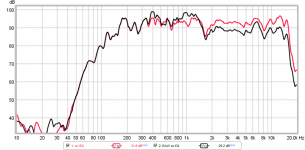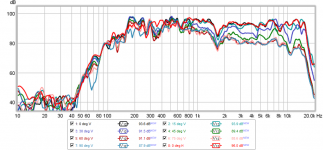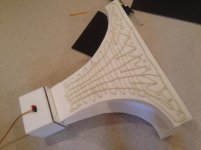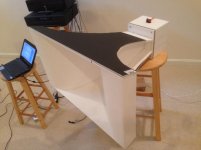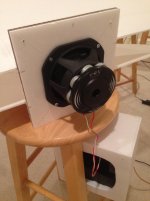Awesome.
Now the fundamental is done, the following reinforcement will be relatively easy. Probably more time consuming, though.
HF is affected by the throat size and its relationship with Sd.
Have you read this? Phase Plugs
CLS,
Thanks for that link! No have not seen that although I was already thinking along same lines. However, my luck has provided me 15khz on axis already. I am kind if surprised actually because the throat area is smaller than Sd by a little bit. I set it square with vertices at middle of surround accordion. I was thinking of casting a phase plug out of plaster on top of the cone separated by plastic wrap. I would insert channels and ducts through wet plaster and remove when hard. There is something very different about how a horn sounds vs an open faced direct radiator. I guess it is louder and more direct. Having fun though.
Yeah, horns can sound different, but not only because of the sound they might impart but what they remove... One of the major differences you might encounter is the horn eliminating early wall reflections due the narrowed radiation angle, so the room is less involved.
Because horns constrain and direct energy most HOM's or resonant modalities incurred by imperfections in the horn itself will be concentrated (iteratively) and re-broadcast that much more strongly to the listener. With a box speaker diffractions from edges are often re-radiated into 180deg or even 270deg of space thus diluting the overall level of the diffraction with respect to the direct signal. Horns aren't as forgiving which is why they are so demanding in their design.
I have heard a number of optimized horns with round throats and mouth round overs that don't have much of a sound beyond being more energetic/dynamic than a OB or direct radiator. The reduction in cone movement and watts should in theory bring the lowest distortion system possible, given the designed horn has no error.
After years of research I concluded the JMLC profile is probably the most well behaved for a "horn" and Geddes Oblate profile the best for a waveguide, but SEOS / econowave type horns sound great within their bandwidth such as the ones used on QSC monitors and It seems tractrix and expo do the job really well in most cases.
I wouldn't underestimate how much of the horn's material vibration is becoming part of it's sound...
fwiw, I wouldn't hesitate to mix tracks on a funktion one top-horn, although it has a less open sound given the reduction of room interaction.
my 2cents.
Because horns constrain and direct energy most HOM's or resonant modalities incurred by imperfections in the horn itself will be concentrated (iteratively) and re-broadcast that much more strongly to the listener. With a box speaker diffractions from edges are often re-radiated into 180deg or even 270deg of space thus diluting the overall level of the diffraction with respect to the direct signal. Horns aren't as forgiving which is why they are so demanding in their design.
I have heard a number of optimized horns with round throats and mouth round overs that don't have much of a sound beyond being more energetic/dynamic than a OB or direct radiator. The reduction in cone movement and watts should in theory bring the lowest distortion system possible, given the designed horn has no error.
After years of research I concluded the JMLC profile is probably the most well behaved for a "horn" and Geddes Oblate profile the best for a waveguide, but SEOS / econowave type horns sound great within their bandwidth such as the ones used on QSC monitors and It seems tractrix and expo do the job really well in most cases.
I wouldn't underestimate how much of the horn's material vibration is becoming part of it's sound...
fwiw, I wouldn't hesitate to mix tracks on a funktion one top-horn, although it has a less open sound given the reduction of room interaction.
my 2cents.
Last edited:
New EQ with Polar Data & Sound Clip
Here is the polar response with the new EQ optimized for this horn.
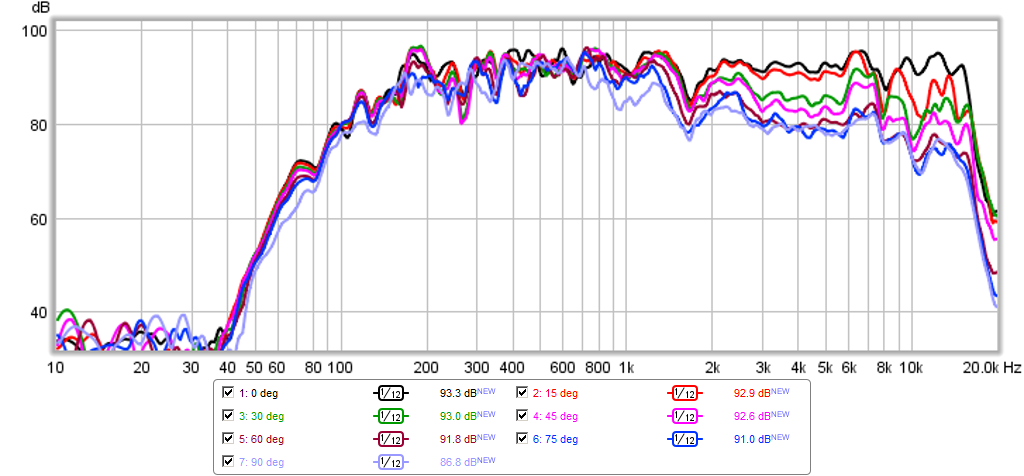
Even with all the panel vibrations, the sound is pretty good. I can imagine that once I get rid of the vibrations, this can sound very clean. One thing I am noticing is that the horn appears to really be loading the cone movement well. If I stick my hand all the way in and touch the cone, it barely moves but the sound pressure and vibrations coming out are much larger than one would expect from such tiny movements.
Here is a sound clip in mono (right channel) with sub XO at 175Hz.
Here is the polar response with the new EQ optimized for this horn.

Even with all the panel vibrations, the sound is pretty good. I can imagine that once I get rid of the vibrations, this can sound very clean. One thing I am noticing is that the horn appears to really be loading the cone movement well. If I stick my hand all the way in and touch the cone, it barely moves but the sound pressure and vibrations coming out are much larger than one would expect from such tiny movements.
Here is a sound clip in mono (right channel) with sub XO at 175Hz.
Attachments
Last edited:
Chapeau xrk971,
If you get that dip ironed out...
If you get that dip ironed out...
An externally hosted image should be here but it was not working when we last tested it.
I got my fingers crossed for yaI am debating whether or not to pull the rear chamber off to test if it is the back reflection causing that dip.
..... I am debating whether or not to pull the rear chamber off to test if it is the back reflection causing that dip.
Tractrix combined with Nautaloss a little technical advanced but
Here is the polar response with the new EQ optimized for this horn.

Even with all the panel vibrations, the sound is pretty good. I can imagine that once I get rid of the vibrations, this can sound very clean. One thing I am noticing is that the horn appears to really be loading the cone movement well. If I stick my hand all the way in and touch the cone, it barely moves but the sound pressure and vibrations coming out are much larger than one would expect from such tiny movements.
Here is a sound clip in mono (right channel) with sub XO at 175Hz.
Looks very cool X!
I also get some panel vibration with 15mm plywood. One can listen to the vibration's spectral content by sticking ear against the horn
The horizontal polars look tractrix-kind with the increasing directivity towards the HF. The narrowing coverage also helps the HF to get back up (by alot, 10-20db in your case!), some might forget that. If you would have done contant directivity horn (ie. conical) your HF response would be much less.
What kind of frequency shaping did you use and what does the raw 0 deg response look like?
Have you measured vertical polars yet? Those would also be interesting.
By the way your horn's geometry reminds me greatly of a P.audio horns that I have laying around here, P. Audio PH-4530!

Last edited:
I made a 5.25 liter rear chamber lined it with grey foam, added binding posts and quick disconnects. The driver mounts to the horn flange then the box covers the back of the driver and is screwed on tight.
Initial listening tests indicate that the panels vibrate a lot so I will have to add bracing later. However, the naysayers who said nothing more than 5kHz will get through, and they also said the polar directivity won't have anything off axis to speak of, they are, fortunately, all wrong. The tractrix as designed indeed lets HF's through and works off-axis. I get 15kHz on axis and it drops off with angle but clearly this is substantial HF getting out of the horn. Some rough polars (+/- 3 deg) show that the directivity is not bad. Up to +/- 30 deg is very respectable. I did not have time to remove the baffle step shelf EQ from the Nautaloss so this is certainly not optimized. I need to give it a rising response so that it will be flat, but this driver has lots of headroom so that should not be a problem. The 1.7kHz dip corresponds to 4in - probably the rear chamber reflection. Ideally a Nautaloss back chamber would be ideal.
Have you sim this with hornresp? I did and I get not the export well, the two straight plates up and down is a problem when export the horn with hornresp, maybe you can tell me how you did this, I do like this one, and want a two way for home use covering 80 Hz to 20 Khz, if that low will work, but hornresp say yes.
The horn looks more exponential then tractrix to my eyes.
thanks
kees
Attachments
Legis,
Thanks for checking it out and the encouragement. I guess you have enough of a system on your hands but you should fire up that old tractrix horn you have lying around. I forgot to save the raw response but it needed a few notches (6.7khz for same breakup mode reduction, and 400Hz) and a high shelf from 1200Hz and I added another one up high at 13khz for more "air". The negative notch at 1.04kHz is the one I would have preferred not to use but I made it wide. Following the general practice of not applying positive peak EQ, if notches go wide and stay away from 500Hz to 5kHz range. Here is the PEQ snapshot of what was applied. I will have to retake the raw data when I do vertical polars (by flipping horn 90 deg).
I forgot to save the raw response but it needed a few notches (6.7khz for same breakup mode reduction, and 400Hz) and a high shelf from 1200Hz and I added another one up high at 13khz for more "air". The negative notch at 1.04kHz is the one I would have preferred not to use but I made it wide. Following the general practice of not applying positive peak EQ, if notches go wide and stay away from 500Hz to 5kHz range. Here is the PEQ snapshot of what was applied. I will have to retake the raw data when I do vertical polars (by flipping horn 90 deg).
Thanks for checking it out and the encouragement. I guess you have enough of a system on your hands but you should fire up that old tractrix horn you have lying around.
Attachments
Last edited:
Vertical Polar Measurment
I rotated the speaker 90 deg about its axis in order to do the vertical polars. It seems there is a floor bounce that is more pronounced than the other orientation. It is pretty flat over +/- 30 deg. Also shown in the 0 deg horizontal trace for comparison. Note that this is using a newer EQ where I smoothed out the peak that was at 180Hz and I reduced the notch at 1.04kHz (actually shifted to 1150 Hz).
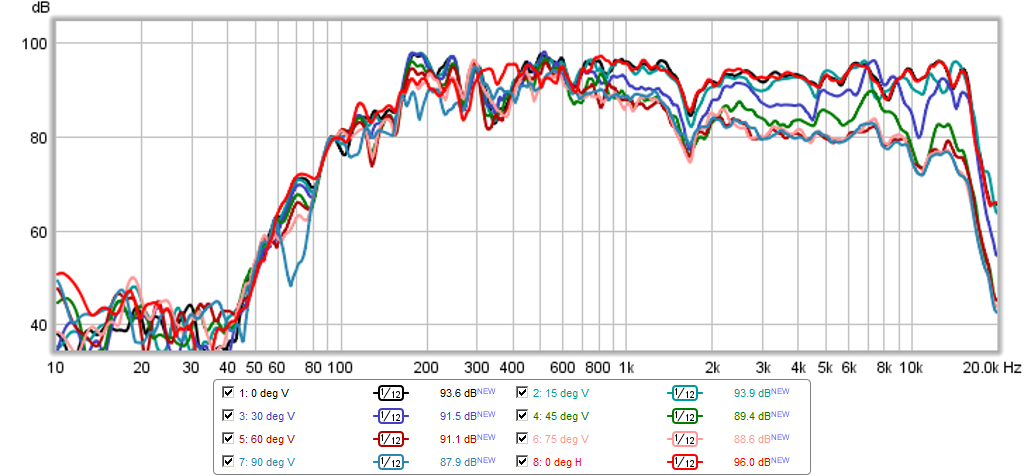
I rotated the speaker 90 deg about its axis in order to do the vertical polars. It seems there is a floor bounce that is more pronounced than the other orientation. It is pretty flat over +/- 30 deg. Also shown in the 0 deg horizontal trace for comparison. Note that this is using a newer EQ where I smoothed out the peak that was at 180Hz and I reduced the notch at 1.04kHz (actually shifted to 1150 Hz).
Attachments
Indoors. Let me give that IR window a try. I am adding a second layer of foam with household latex caulking in between for a constrained layer damping. Just finished top and bottom. The curved sides will be tricky because need to make another curved panel and needs to be clamped while drying... Maybe add patches of CLD rather than one big sheet?
Thanks for posting a clip. It's pretty even sounding. Sibilance is a bit more obvious but I think that's in the recording.
Not to become a broken record but a mono horn will usually sound more closed in and less realistic than a mono box speaker because it lacks the early room reflections that make for pseudo-stereo ambiance. I think you'll find the horn more source accurate in stereo config than stereo OB or IB for the same reason. Room treatment nulls this consideration and puts both alignments on even footing with regards to source accuracy.
Would love to hear more cymbals in the next recording since the hf loading/performance is so debated.
Not to become a broken record but a mono horn will usually sound more closed in and less realistic than a mono box speaker because it lacks the early room reflections that make for pseudo-stereo ambiance. I think you'll find the horn more source accurate in stereo config than stereo OB or IB for the same reason. Room treatment nulls this consideration and puts both alignments on even footing with regards to source accuracy.
Would love to hear more cymbals in the next recording since the hf loading/performance is so debated.
Thanks for posting a clip. It's pretty even sounding. Sibilance is a bit more obvious but I think that's in the recording.
Not to become a broken record but a mono horn will usually sound more closed in and less realistic than a mono box speaker because it lacks the early room reflections that make for pseudo-stereo ambiance. I think you'll find the horn more source accurate in stereo config than stereo OB or IB for the same reason. Room treatment nulls this consideration and puts both alignments on even footing with regards to source accuracy.
Would love to hear more cymbals in the next recording since the hf loading/performance is so debated.
More cymbals coming up soon. If you have a YouTube clip that you think demonstrates high freq well let me know and I will play/record it through the horn. I am working on reducing panel vibs at this point I think things are looking optimisct that this should go to the next stage of being made of wood or fiberglass, etc. without too much risk that it will be a flop.
Sound Clips with Cymbals
Ok, here is what I have on hand that has cymbals. It's from the Jazz Undeground, Live at Small's.
Here are some progress photos of the constrained layer damping that I have managed to add to the top and bottom (latex caulking between 2 layers of foam core). I also trimmed down the panels to reduce radiator area for sound emission.
Liberal dose of latex caulking for the constrained layer:
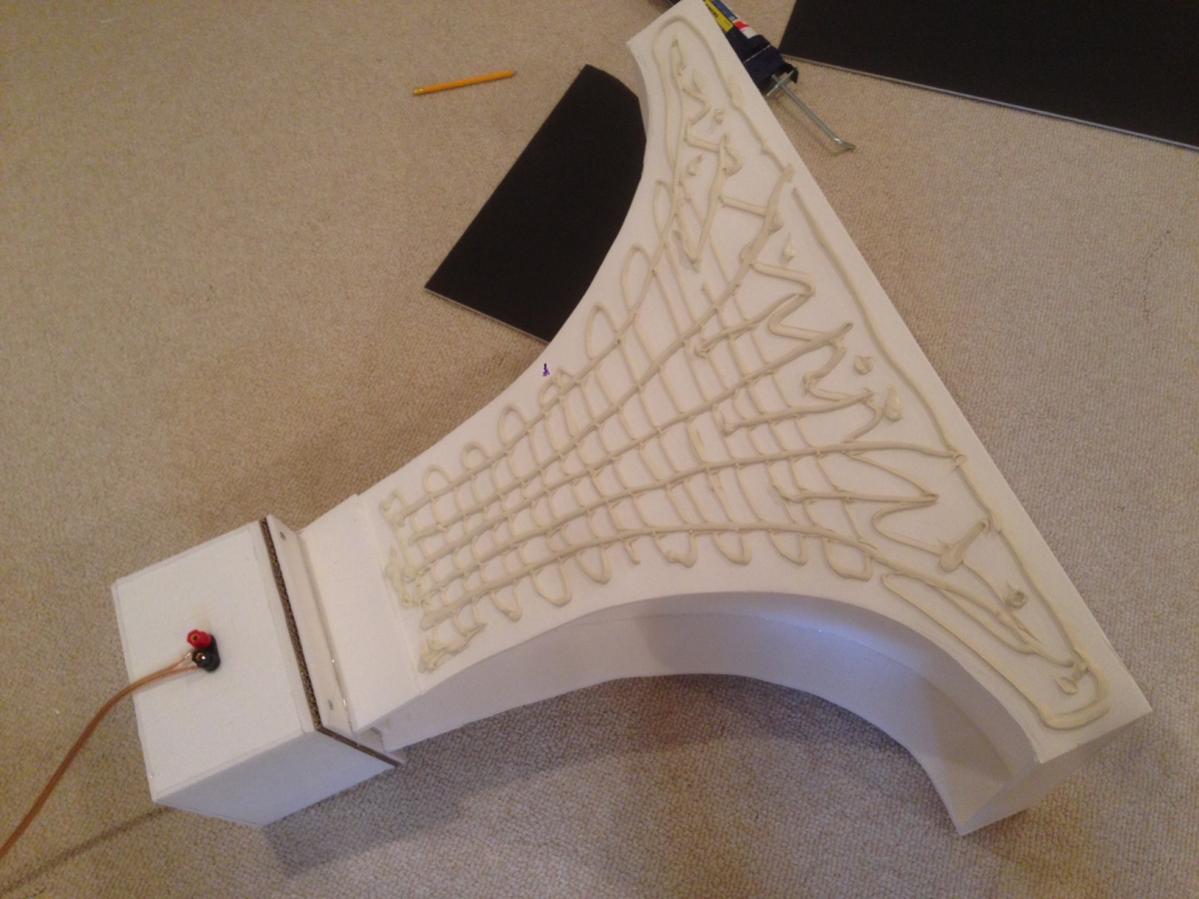
Panels added on top of caulking:
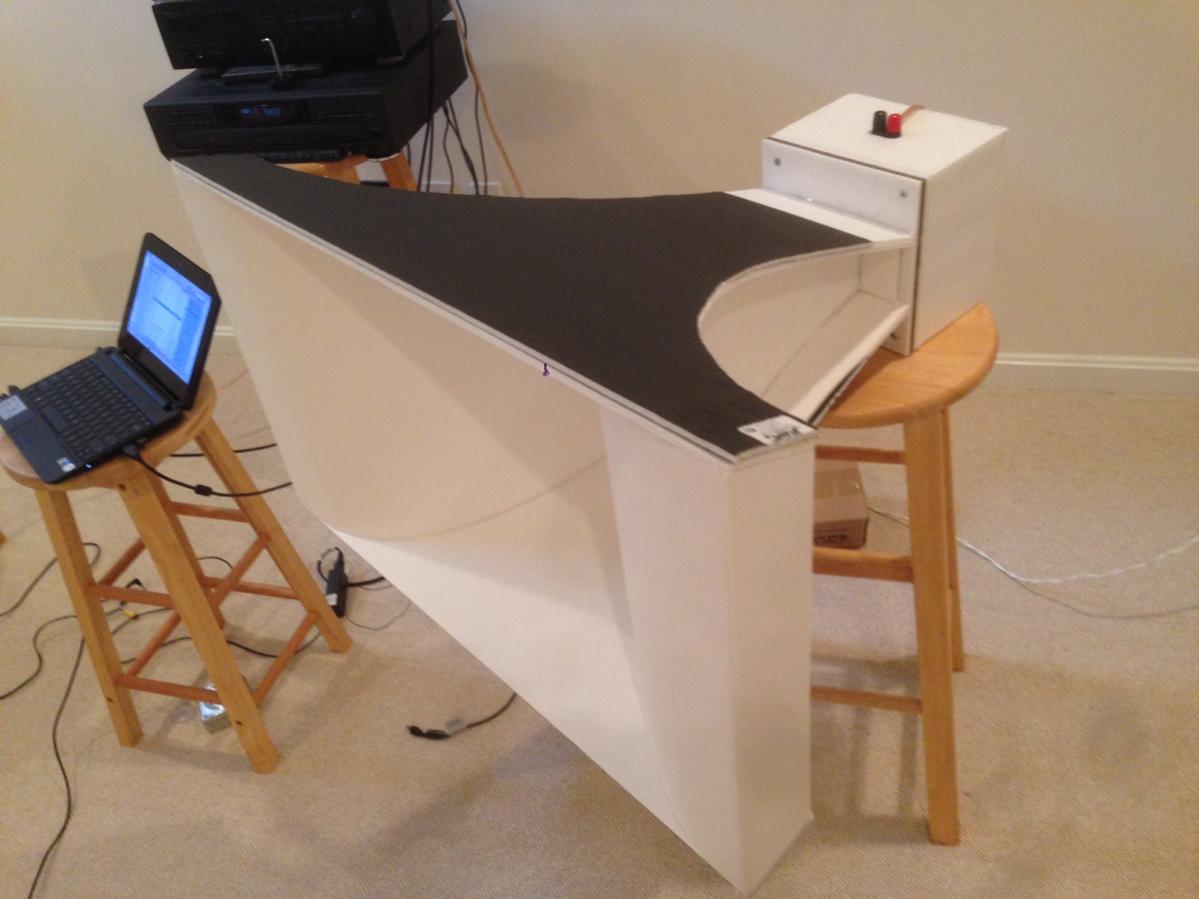
Closeup of the driver and driver chamber (sitting below) - that's a lot of Nd magnets for a 5 inch driver:
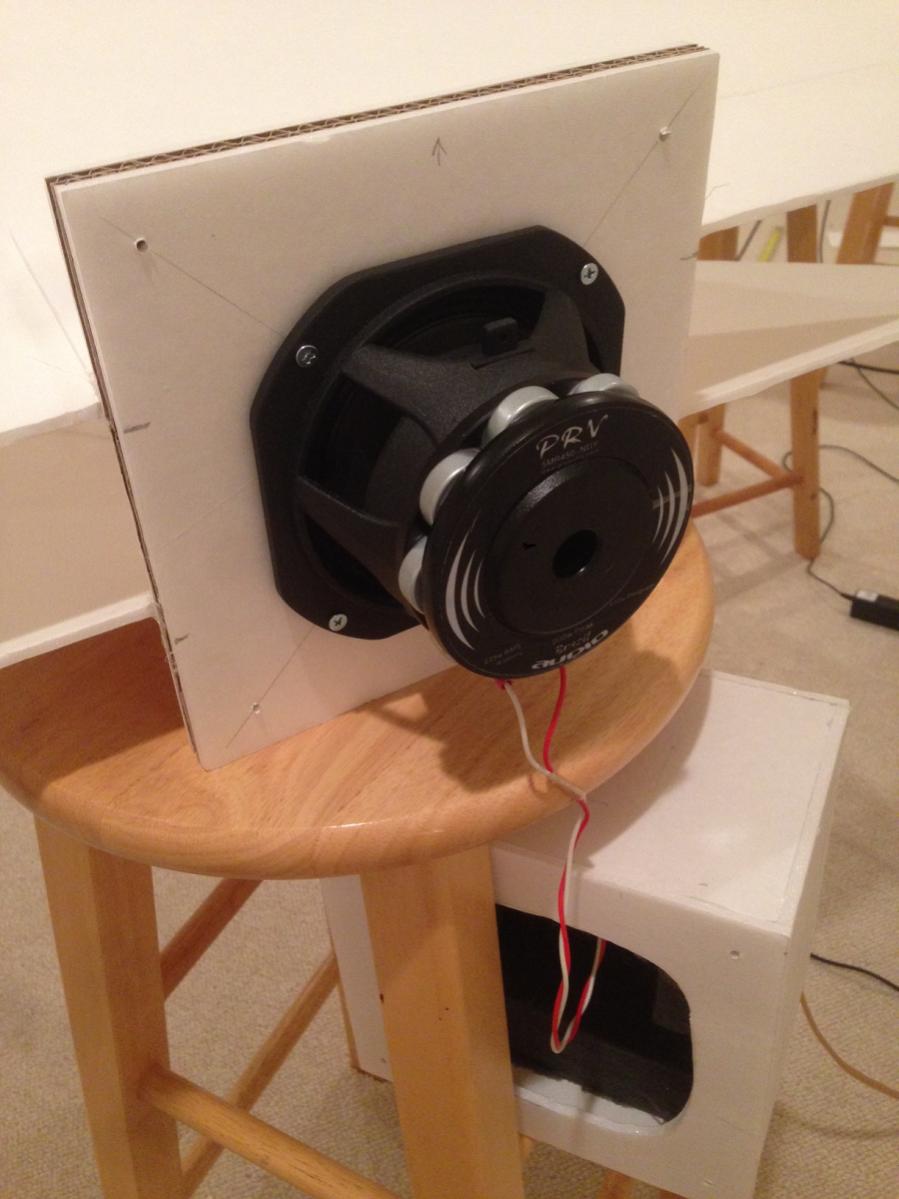
Sound clips below...
Ok, here is what I have on hand that has cymbals. It's from the Jazz Undeground, Live at Small's.
Here are some progress photos of the constrained layer damping that I have managed to add to the top and bottom (latex caulking between 2 layers of foam core). I also trimmed down the panels to reduce radiator area for sound emission.
Liberal dose of latex caulking for the constrained layer:
Panels added on top of caulking:
Closeup of the driver and driver chamber (sitting below) - that's a lot of Nd magnets for a 5 inch driver:
Sound clips below...
Attachments
Chapeau xrk971,
If you get that dip ironed out...
An externally hosted image should be here but it was not working when we last tested it.
NEO Dan,
Unfortunately, that 1.7 kHz dip is not a back reflection but results from a 4.1 in path cancellation corresponding to the diagonal distance from one vertex to the opposite vertex in the horn throat. Only way to fix this is to use a phase plug or maybe make a round throat that transitions to square. So, no hats off to me I guess...
Code for Tractrix Synergy
Kees,
Here is the Akabak script for the tractrix horn with synergy injection port for Kappalites. Remove the comment bar | in front of the OFF switches at each System to look at individual system.
Cheers,
X
This is a sample of the output from this code:
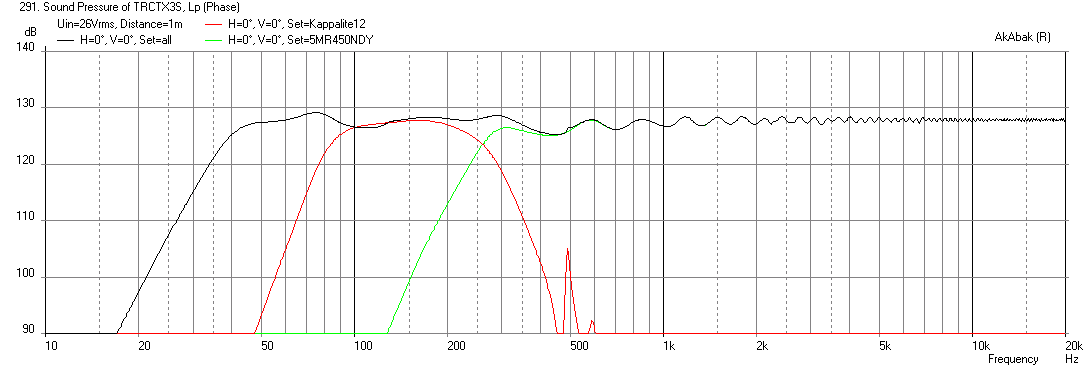
Have you sim this with hornresp? I did and I get not the export well, the two straight plates up and down is a problem when export the horn with hornresp, maybe you can tell me how you did this, I do like this one, and want a two way for home use covering 80 Hz to 20 Khz, if that low will work, but hornresp say yes.
The horn looks more exponential then tractrix to my eyes.
thanks
kees
Kees,
Here is the Akabak script for the tractrix horn with synergy injection port for Kappalites. Remove the comment bar | in front of the OFF switches at each System to look at individual system.
Cheers,
X
This is a sample of the output from this code:

Attachments
Last edited:
- Home
- Loudspeakers
- Full Range
- PRV 5MR450-NDY for FAST/WAW applications
